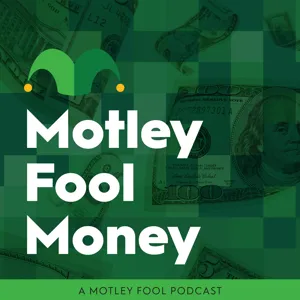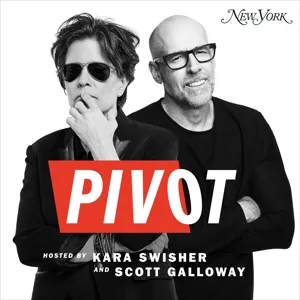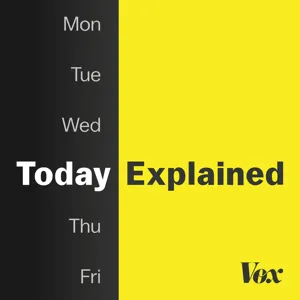Podcast Summary
Insights and discussions on NFL draft and team strategies: The Ringer NFL draft show offers valuable insights and discussions on NFL draft and strategies to improve NFL teams, hosted by Danny Heifetz and featuring Danny Kelly, Ben Solak, and Craig Krollback, with sponsors Indeed and Canva.
The Ringer NFL draft show, hosted by Danny Heifetz along with Danny Kelly, Ben Solak, and Craig Krollback, provides valuable insights and discussions on NFL draft and strategies to improve mediocre NFL teams. The show is brought to you by Indeed and Canva, offering job listing and hiring solutions, and presentation design tools, respectively. Heifetz also shares his experiences from his recent book talk at Politics and Prose in Washington DC, expressing gratitude towards the audience. He is currently taking a book leave to write a larger original book about the future of economic and technological progress in America and beyond, co-written with New York Times writer and podcaster, Ezra Klein. The podcast will temporarily move to one episode per week, publishing every Tuesday. The show's blend of off-the-news questions and on-the-news analysis will continue, and new episodes, including one about the future of American cities, are already in the works.
Urban Challenges Amidst Economic Shifts: The pandemic and economic shifts have led to challenges for many downtown areas, including high vacancy rates, declining property tax revenue, and fewer commuters. However, the US economy is not in a recession, and economic activity is shifting to the suburbs and sunny cities in the Sun Belt, driven by the remote work revolution.
Cities are constantly evolving, but the recent pandemic and economic shifts have led to significant challenges for many downtown areas. These challenges include high vacancy rates in offices and commercial spaces, declining property tax revenue, and fewer commuters. As a result, some urban thinkers are concerned about an "urban doom loop" where economic activity declines in tandem with services and tax revenue. However, the US economy as a whole is not in a recession, and economic activity is not disappearing, but rather shifting to the suburbs and sunny cities in the Sun Belt. This trend, driven in part by the remote work revolution, could have significant political and demographic implications. To help us understand these trends and their implications, we're joined by Dror Poleg, an author and adviser who writes about the future of cities. We'll discuss the knock-on effects of urban change on finance, work, real estate, and technology.
Remote work trend leading to underutilized office space: A quarter of hours worked are now done remotely, causing significant underutilized office space in major cities, putting pressure on city budgets and raising questions about urban life's future.
The shift to remote work in America, while it has moderated since the initial surge during the pandemic, is still significant and ongoing. About a quarter of hours worked are now done remotely, a major increase from pre-pandemic levels. This trend, along with other demographic shifts like population movement away from large cities, is leading to a significant amount of vacant or underutilized office space in major cities across the country. This erosion of office space utility puts immense pressure on city budgets and raises questions about the future of urban life. As we've seen with the retail industry and the rise of ecommerce, seemingly small shifts in behavior can have major impacts on real estate markets.
Impact of COVID-19 on Cities: Shift to Remote Work and E-commerce: Cities face significant budget shortfalls due to decline in office demand and subway usage during COVID-19, requiring municipal leaders to find ways to make up for lost revenue or face cuts to services or higher taxes.
The shift to remote work and e-commerce brought about by the COVID-19 pandemic has had significant impacts on cities, particularly in terms of revenue for municipalities. Prior to the pandemic, about 13% of retail sales had shifted online over 20 years, taking away growth from traditional retail. Now, with the potential for a similar shift in office demand, the consequences could be even more severe. Cities like New York, where a large portion of tax revenue comes from offices and related businesses, could face major budget shortfalls if demand for office space continues to decline. Additionally, the permanent decline in subway usage in cities like New York means that municipal leaders must find ways to make up for the lost revenue or face the possibility of cutting services or raising taxes. The "urbanizer's dilemma" arises as cities grapple with these conflicting needs, and finding a balance will be key to navigating this disruption.
Cities as consumer products: choosing growth or decline: Cities can respond to economic challenges by improving public spaces, transport, housing, and outdoor dining to become more attractive and retain residents, or they can fall into an urban doom loop.
Cities can respond to economic challenges in two ways: falling into an urban doom loop or using crisis as a stimulant for creative policy. The speaker suggests that cities like New York, with a new mayor focused on improving public transport, public spaces, housing, and outdoor dining, are choosing the latter. They're recognizing that locations are becoming consumer products and that people have choices about where they live and work. By making their cities more attractive, they can retain residents and attract new ones. Cities can also adopt new technologies and infrastructure, such as electric bikes and scooters, to make getting around more convenient. The speaker sees potential for this approach in cities like Washington, D.C., where declining property values and office vacancies could lead to increased housing and alternative transportation options. However, the speaker also acknowledges that this transformation may take time and effort.
Cities' Financial Crises: New York's Denial vs. San Francisco's Experimentation: Mayor Adams in New York is addressing city issues, but denial about severity persists. San Francisco experiments with pushing businesses and residents, but deep-rooted problems remain. Regional banks face a commercial real estate debt crisis, and remote work threatens their survival.
The attitude and urgency with which cities, particularly New York and San Francisco, address their financial crises will significantly impact their futures. Mayor Adams in New York is leaning into policies to address the city's issues, but there's still a denial about the severity of the situation. Meanwhile, San Francisco is experimenting with pushing businesses and residents, but even a tech revival won't solve the deep-rooted problems. Regional banks in America, which have large exposures to office and retail loans, are facing a potential tsunami in commercial real estate finances as debt matures in 2023 and 2024. Wall Street tried to enforce a return to the office, but the remote work phenomenon may now be threatening the banks' survival. Banks once believed they could control the workforce and economy, but the COVID-19 pandemic and the shift to remote work have challenged that notion.
Banks' Office Building Investments Face Uncertainty Amid Remote Work Shift: Banks' investments in office buildings face uncertainty due to the prolonged shift to remote work, requiring reevaluation of valuation and pricing strategies
The banking industry's heavy investment in commercial property lending, particularly in office buildings, has become a significant risk due to the shift to remote work. Banks, assuming that offices would quickly return to pre-pandemic levels, lent out large sums of money to build or refinance office buildings. However, the unexpected longevity of remote work and the changing nature of offices have left these investments less stable and profitable than anticipated. Offices now require more services and amenities to attract tenants, leading to increased operating expenses. Additionally, the commitment and predictability of rental income have decreased. As a result, banks must now reevaluate their valuation and pricing strategies for these assets, treating them as businesses rather than stable financial assets. This irreversible shift in real estate marks a new era for the banking industry.
Real Estate Risks for Regional Banks: Office and Retail Loans: JPMorgan's stress test revealed potential capital losses for banks from high delinquency rates of office and retail loans, adding to economic slowdown, higher interest rates, and pressure on business models, increasing the risk of cascading failures and instability in the office sector.
The role of real estate in financial portfolios is evolving, and this presents new risks for regional banks. A stress test by JPMorgan's investment bank revealed that high delinquency rates for office and retail loans could lead to significant capital losses for banks, potentially causing a new wave of jitters. However, offices alone may not be enough to destroy banks, as they are also dealing with economic slowdown, higher interest rates, and pressure on their business models. The bigger risk is a cascading failure, where one weak area puts pressure on others, leading to more risk-taking or consumer behavior changes. The office sector, once seen as a reliable source of income, is now a potential source of instability. As the nature of work changes, there may be a need for new concepts of what offices are and how they should function in an era of widespread underutilization. The consequences of denying or underestimating these shifts could be costly for banks and landlords alike.
Evolving Office Concept: Customization and Blurred Lines: The office landscape is changing, with a shift towards customization and blended spaces, requiring real estate companies to adapt and potentially split into entities for stable rentals and experimental services.
The concept of an office is evolving rapidly and becoming more dynamic than ever before. It's no longer enough to build a single type of space and expect it to cater to all types of tenants. Instead, businesses must segment their product, focus on specific groups of people, and constantly respond to their needs. This shift towards customization requires a deeper change in the real estate industry, with companies potentially having to split into two entities: one for managing stable rental properties and the other for experimenting with new services and branding. Additionally, the lines between home and office are blurring, with people working from home and coffee shops, and hotels experimenting with coworking spaces. This trend towards blended spaces will continue to challenge the traditional real estate industry and force innovation.
Blending Urban Spaces: A Return to Historical Norms: Cities are moving towards more blended and mixed-use urban spaces, as seen in establishments like the Ace Hotel. This trend is a response to the demand for more attractive and livable cities and a return to historical norms.
The future of urban spaces is heading towards a more blended and mixed-use model, as seen in places like the Ace Hotel and hybrid establishments that combine dining and cocktail bars. This trend is not new, as urban offices once started in coffee shops, and even the New York Stock Exchange began in a coffee house. The industrial era's separation of uses through zoning laws may no longer be necessary or effective, as cities like Tokyo, London, and Paris demonstrate vibrant urban life with more lenient zoning. Manhattan, for instance, could accommodate a million more people by allowing for denser populations, which requires a shift in thinking from governments. This blending of urban spaces is a return to the historical norm and a response to the demand for more attractive and livable cities.
Downtown recovery rates vary significantly among cities: The Sun Belt and Central Valley California cities show the strongest bounce-back due to Americans shifting away from colder, coastal cities, economic structures, and dependence on public transportation in urban areas.
The pandemic has led to significant differences in downtown recovery rates among cities, with those in the Sun Belt and Central Valley California showing the strongest bounce-back. Factors contributing to this trend include Americans' gradual shift away from colder, coastal cities, the economic structures of innovative, high-pay cities, and the dependence on public transportation and long commutes in urban areas. The University of Toronto Downtown Recovery Project's findings reveal the continuation of long-term trends, with cities like San Francisco, Cleveland, Indianapolis, Louisville, Portland, and Seattle experiencing weak recoveries. It's essential to consider these factors when assessing the future of city fortunes.
Cities adapting to distributed workforces and R&D: As technology advances and remote work becomes more common, cities must adapt to remain competitive and inclusive, accommodating distributed workforces and research activities in multiple locations while addressing concerns of segregation and inequality.
The role and purpose of cities are evolving as technology advances and remote work becomes more common. Employers are no longer limited to hiring from a single city, leading to a trend of distributed workforces and research and development activities in multiple locations. This shift has the potential to make cities more competitive and provide more opportunities for individuals, but it also raises concerns about segregation and inequality as those with more resources may move to desirable areas, leaving cities with fewer resources behind. The future of cities will depend on their ability to adapt and accommodate everyone, ensuring that they remain inclusive and vibrant places to live and work.
Finding a way for everyone to coexist and thrive in urban and suburban areas: Governments must address infrastructure demands and allay fears of middle-income voters to increase housing and density in suburbs while maintaining urban amenities
As we strive for prosperity for all, it's important not to alienate successful individuals or businesses. We need to find a way for everyone to coexist and thrive. This concept has been a challenge for decades, especially in relation to urbanization and suburbanization. The doughnut effect, where real estate values have hollowed out in city centers and plumped up in suburbs, has been ongoing for a long time. As millennials move from cities to suburbs, they bring their urban tastes with them, potentially leading to the urbanization of suburbs. This trend is already seen in many suburbs, which have high streets filled with trendy shops and amenities. However, building these urban-style developments in suburbs is challenging due to zoning laws that favor single-family homes and lack of infrastructure. To address this, governments need to prove they can handle the infrastructure demands and allay fears of middle-income voters. In summary, we need to find a way to increase housing and density in suburbs while addressing the concerns of residents.
The Future of White Collar Work: A Wild Ride with AI: The ongoing AI revolution is disrupting white collar work, leading to unprecedented changes in the labor force and cities. Almost all occupations are becoming scalable, creating opportunities for some and challenges for others. Remote work and AI are interconnected, paving the way for a future where everyone competes domestically and internationally.
The future of work, particularly white collar work, is expected to undergo significant changes due to the ongoing AI revolution. This change is already underway, and we're in the early stages of what AI and large language models like ChatGPT could ultimately become. The impact on the labor force and American cities could be profound, with potential ripple effects similar to the remote work revolution. The pace of change is expected to be unprecedented over the next 20 years, leading to a world where almost all occupations become scalable. This means that some people will be able to make more money and serve more customers than ever before, but everyone will be competing with each other domestically and internationally. Even the winners may not sleep well at night, as their shelf life and career stability could be shorter. This trend is already evident in industries like music and fitness, where scalable careers have disrupted traditional industries. Remote work and AI are interconnected, as remote work has made work more modular and text-based, paving the way for AI to automate and transform various industries. The future of work is uncertain, but one thing is clear: it's going to be a wild ride.
A new era of 'superstar effects' in the digital world: The integration of AI and remote work could lead to a global shift in 'superstar effects', challenging traditional notions of geographically concentrated success and creating new opportunities for individuals to thrive in various industries online.
The integration of AI into the workforce and the shift towards remote work could lead to a new era of "superstar effects" where a select few individuals in various industries, regardless of location, could see astronomical rewards. This could challenge the traditional notion of geographically concentrated superstars in cities like Los Angeles, New York, and San Francisco. Instead, the Internet could become the biggest agglomeration, with several large industries having their own hubs within it. The rise of the scalable class, where individuals must compete on a global scale and constantly stay vigilant, is the new reality. The Internet, in essence, becomes a city in itself, with various industries having their own districts. This shift could lead to a need for new social solutions and support systems as work loses its traditional meaning as a source of meaning and identity.
The Internet's Impact on Cities and the Future Workforce: The Internet may decrease the importance of cities from an economic perspective, and performativeness may become a concern in the future workforce, but fragmented royalty systems may allow for valuable building block creation and distribution.
The importance of cities from an economic perspective may decrease due to the growing impact of the Internet. The Internet is still in its infancy, and its effects on society are just beginning to be understood. This is evident when we look back at the impact of the telephone and how it changed the way we communicate. It's impossible to predict the full extent of the changes that will occur over the next few decades, let alone a century. Another observation from the discussion is the potential importance of performativeness in the future workforce. With the rise of broadcast media and the economic rewards for being a top performer, there is a concern that this may not be a civic virtue. However, there are ways for individuals to produce valuable building blocks and receive royalties without becoming the face of the product or service. The future may hold fragmented royalty systems that allow for this type of value creation and distribution. Overall, the discussion highlights the significant changes that are occurring in our society due to technology and the Internet, and the importance of adapting to these changes in order to thrive in the future.






